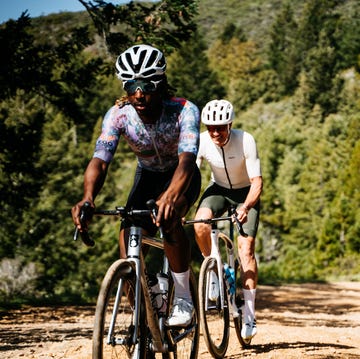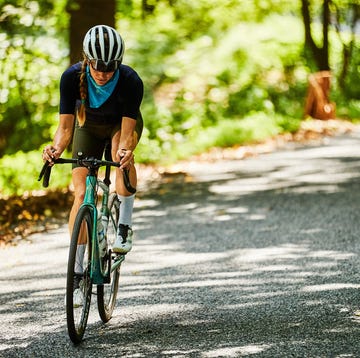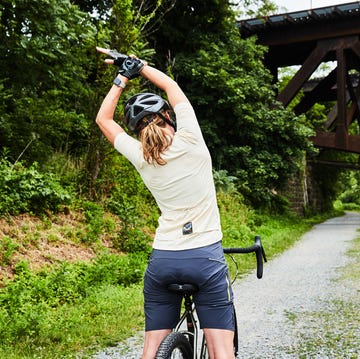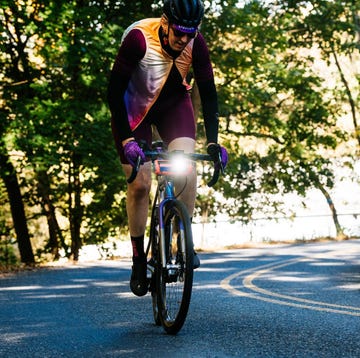Every cyclist knows at least something about balance—it’s how we stay upright on the bike after all. But there aren’t many of us who make it a point to work on our balance (at least, not since we toddled off without our training wheels). That’s to our detriment, though, because balance is what keeps you comfortable in the saddle and makes you more efficient, whether you’re riding on the road or the trail.
Sure, all athletes require decent balance skills, but cyclists are unique because they need to use those skills when their feet are off the ground, says Lisa Folden, D.P.T., a physical therapist specializing in orthopedic and neurological injury rehabilitation. “For this reason, the vast majority of their balance is drawn from having a well-developed and stable core, which consists of the entire trunk (upper back and shoulder muscles to the lower abs, hips and glute muscles),” she says. “That’s why exercises like single-limb stances and standing on foam aren’t quite as helpful as moves that work the core.”
“Doing balance training exercises off the bike can help you maintain better control of your body position while riding,” says Nakia Gaither, a fitness consultant and instructor for Detroit Fit at the Lexus Velodrome in Detroit. Start adding these seven moves into your regular workouts, and you’ll feel confident navigating whatever twists, bumps, or obstacles you encounter on the road. “If you’re stable head to toe, you’re in the best position to ride without pain, falls, and injuries,” Folden says.
How to use this list: The seven balance exercises below are demonstrated by Brian Levine, certified personal trainer, instructor at Flywheel, and Ironman athlete so you can see proper form. Get familiar with each, then follow the reps and sets indicated for each move.
Join Bicycling All Access today for more killer workouts! 💪
1. Single-Leg Squat
What it does: “When done properly, the single-leg squat helps to build the muscles of the upper thigh, which is super important for cyclists thanks to all that repeated pedaling,” says Folden. Plus, “cyclists generally favor one side over the other while riding, which increases their chance of muscle fatigue and can lead to imbalance and injury,” says Gaither. The unilateral (or one-sided) aspect of this move requires engaging the core and the hip muscles, which have to be stable in order for you to support yourself in the saddle.
How to do it: Start in a standing position with feet parallel, arms at sides. Shift weight to right leg as you raise left foot off the ground and extend left leg out. Hinge at the hips and bend the right knee as you slowly push hips back and lower into a sitting position without letting the knee extend past your toes. Lift arms straight out to counterbalance. Press through right foot and straighten right leg to come back to starting position. Do 3 sets of 12 reps, then repeat on the other leg.
This is a challenging move. To build up to it, rest your fingertips on a chair or wall for balance as you lower down into the squat. Work your way up to not needing assistance.
2. Russian Twist
What it does: “While riding for long periods of time, a cyclist may begin to relax their abdominal muscles, which can result in a slouching position that puts more pressure on the spine and creates alignment issues,” says Gaither. “This exercise not only tightens and cinches the waist, it keeps the trunk super tight and super strong,” says Folden. “You absolutely can not balance on a bike if your trunk muscles are not working efficiently.”
How to do it: Sit on the floor with your back straight and knees bent. Lift feet off the floor and lean back to a 45-degree angle. Clasp hands together, then twist from your torso side to side as you reach hands to floor keeping your abdominals activated. (For more intensity, add a 2- to 5-pound dumbbell or extend the legs out.) Do 3 sets of 12 to 15 reps.
3. Single-Leg Bridge
What it does: “Strengthening and stabilizing the hips muscles, especially the gluteus maximus, helps to sustain balance on your seat while repeatedly pedaling your legs,” says Folden. “It can also take pressure off the lower back and decrease back pain, which is common among cyclists,” says Gaither.
How to do it: Start lying faceup with knees bent, feet on floor, firmly pressing your lower back into the mat. Squeezing your glutes, lift hips up toward the ceiling. Extend left leg out straight, driving through the right heel, and hold for 30 seconds. Then lower the hips down. Rest for 10 seconds then repeat on the other side.
4. Downward Dog
What it does: “A cyclist’s power is in their glutes, hamstrings, and calves,” says Gaither. “Overuse of these muscles can lead to tightness and cramping, which can cause imbalances and eventually injuries. This common yoga pose helps to release tension in the spine and stretches out the hips, hamstrings, and calf muscles.”
How to do it: Start in a high plank position with wrists under shoulders and core and glutes activated so body forms a straight line from head to heels. Taking a deep inhale, press palms and hands firmly into the mat with fingers spread as you send hips up and back pressing your chest toward your toes. Relax the back, head, neck, and shoulders. Hold for 10 seconds and exhale as you lower back down. Repeat as needed.
5. Plank
What it does: “The plank is a must-do exercise for your core, which is the absolute center of all balance,” says Folden. “If your trunk is stable and strong, maintaining your posture on the bike and adjusting to twists and turns on the road will be a breeze.”
How to do it: Start on all fours with wrists under shoulders and knees under hips. Engage your abdominals and step feet back into a high plank, making sure your wrists are directly under your shoulders and abs and glutes are engaged so body forms a straight line from head to heels. Hold this position for 30 seconds and repeat twice. For more of a challenge, increase the time to 45 and 60 seconds.
6. Seated Glute/Piriformis Stretch
What it does: “The Piriformis muscle acts as a stabilizer for the hips,” says Gaither. “Spending long periods of time in the saddle can lead to tightness in your hips, which can then cause muscular imbalances, muscle spasms, and potentially sciatic nerve pain. This stretch opens up the hips, giving a rider more balance and flexibility.”
How to do it: Sit in a chair and cross the left leg over the right, bringing the left ankle to the right knee. Engage your abs and bend forward at the hips, keeping your back as straight as possible—don’t curl your spine as you bend forward. Hold for 30 seconds, then relax and repeat on other side.
7. Single-Leg Deadlift
What it does: “The deadlift builds the strength of your hamstring muscles, on the back of your thighs, which are important to counterbalance and support the actions of the quad muscles on the front of the thighs,” says Folden. “The repeated flexion and extension of the knee when riding could easily result in a sprain, strain, tear or cramp of the hamstring muscle, so ensuring this muscle is strong and flexible is key. And the single-leg balance component calls for effort from the core, which will assist in adjusting to changes in the terrain and direction when riding.”
How to do it: Stand with feet parallel, arms at sides. Keeping the hips squared, slightly bend the left knee and begin to lean forward, hinging at the hip until your torso is parallel with the floor as your right leg extends straight back behind you. Return to a standing position and repeat. Do 3 sets of 12 to 15 reps on each leg. For an added challenge, hold a moderately heavy dumbbell in one hand.
All Images: Julia Hembree Smith



















